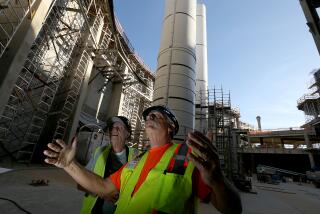Tinkertoy-Like Structure Built by Space Walkers
- Share via
HOUSTON — Astronauts Jerry Ross and Sherwood Spring donned space-helmet hard hats Friday and stepped outside the orbiter Atlantis to begin the first construction job in space.
The Tinkertoy-like structures they put together were only a simple truss and a pyramid, but the techniques they used are also expected to be used in construction of the first space station sometime in the 1990s. They will have a second construction session Sunday.
Ross and Spring started off rapidly and in light spirits with a project called ACCESS, a 45-foot-tall triangular truss assembled from 93 aluminum struts and 33 nodal joints. Either three or four struts are attached to each node and held in place by spring-loaded sleeves.
The structure is assembled on a lazy Susan-like fixture. Twelve struts are connected by nodes to form one cell or bay. After the astronauts assembled each bay, they slid it upwards and added another to the bottom. They repeated this process until--in less than 40 minutes--all 10 bays were complete, then they immediately began to disassemble ACCESS in the reverse order.
After a couple of bays had been completed, Spring asked mission control: “Need any space stations you want built? Condos?” By the time they reached bay nine, well ahead of schedule, pilot Brian O’Connor told them: “You guys are looking great,” and Ross replied: “We feel great.”
While they were disassembling the structure, however, one of the astronauts noted that he had sweat in the fingertips of his glove and that he was beginning to feel a little warm.
‘Like Working in Garage’
During the disassembly, the sun went down and the lighting grew dim, despite the floodlights in the payload bay. “It’s like working in your garage . . . at night without very many lights,” Ross noted. Later, he said: “It’s not going down as easily as it went up.”
The two astronauts, calling themselves space ironworkers, completed the task one hour ahead of schedule. However, the elapsed hour and 25 minutes for assembly and disassembly was slightly longer than the time they had previously required to construct and dismantle ACCESS underwater in the neutral buoyancy facility at the Marshall Space Flight Center in Huntsville, Ala.
One of the astronauts said that “I can’t tell the difference from underwater.” A key feature of the experiment is to determine how closely the neutral buoyancy facility mimics construction conditions in space.
If the match is close, engineers will then feel much more confident about testing other space construction techniques underwater.
Some Lighter Moments
Some of the extra time could be accounted for by some high jinks after the tower was erected. Ross and Spring brought out a sign reading “Ace Construction Company”--reminiscent of the “Ace Trucking Company” and “Ace Repair Company” signs of previous missions--and posed for pictures.
After stowing the ACCESS materials, the pair began to build EASE, an inverted tetrahedron, or pyramid, formed from six 12-foot-long aluminum beams and four nodal joints. It fits together much like ACCESS, but the individual pieces are much larger and heavier.
During the EASE project, the astronauts were clearly working much harder, and they became notably less chatty. The increased difficulty came because they were working while floating free rather than having their feet restrained.
At one point, however, Ross said: “It feels good to do some good honest work.”
The pair’s facility at their task increased sharply. In the first cycle of EASE, the astronauts required 12 minutes to build the pyramid and nine minutes to stow it. By the fourth cycle, it took them nine minutes to build and 5.5 minutes to stow.
‘Slapping Things Together’
Said Spring: “We’re really slapping these things together. I just wonder how fast we could do it if we really had to.”
Ross and Spring finished their building and stowing work in five hours and 32 minutes. They had been scheduled for six assembly-disassembly cycles of the pyramid, but they worked so quickly that they completed eight.
The EASE and ACCESS structures “do not represent any actual parts of the proposed space station,” according to Ed Valentine, project manager of the program for the Marshall Space Flight Center. Instead, they are simple structures that incorporate “all the techniques we would need to assemble something in space.”
The rest of the mission has been running “exactly as time-lined,” according to flight director Chuck Shaw. Atlantis, he said, is a “perfect shuttle.”
All of the scientific projects are proceeding on schedule. The only glitch so far has been the failure of one of four video recorders, which ground personnel said would lead to the loss of a small amount of data.
A somewhat larger concern, at least to the press and to the mission’s scientific sponsors, has been the relatively limited communication with Atlantis and the ground. Astronauts are normally told informally to limit extraneous chatter with the ground. Mission commander Brewster Shaw, however, has apparently ordered them to limit their conversations even more than normal.
Update on Experiments
“This is one of the quietest shuttle missions I have ever not heard,” said one observer at the Johnson Space Flight Center. At one point Thursday, at the sponsors’ behest, mission control had to ask the crew about the status of the various scientific experiments.
Television transmissions from Atlantis are also more limited than normal. Because of the haste to get Atlantis launched so the next scheduled mission could be completed before Christmas, the antenna normally used for television transmissions could not be installed.
Television signals can thus be relayed to the ground only when the satellite is over Hawaii, California or Florida.
More to Read
Sign up for Essential California
The most important California stories and recommendations in your inbox every morning.
You may occasionally receive promotional content from the Los Angeles Times.













